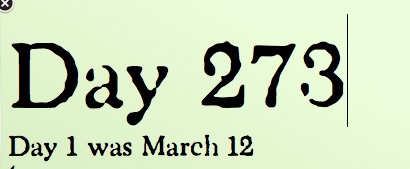(This column originally appeared in The Des Moines Register on Dec. 1, 2020.)
When will this end?
During the coronavirus pandemic, we keep asking this question, continually changing our expectations.
In March, when COVID-19 reached us, many were naively optimistic. In a few weeks, we thought, the virus will pass through and like a blizzard, we’ll push it aside and get back to our lives. While we wait, we’ll just binge watch several multi-part, multi-season TV series!
But it became clear it was going to take longer. In late March, I envisioned a worst-case scenario: We wouldn’t be back to normal until Memorial Day. (But I dared not express such pessimism because it was so discouraging.)
On April 15, I retroactively began counting the pandemic’s days. For me, Day Zero was March 11, the day the NBA suspended its season and husband-and-wife actors Tom Hanks and Rita Wilson tested positive for the coronavirus. I made March 12 be Day 1, making April 15, the day I started counting, Day 35. Keeping track of the pandemic. A "sticky" note on my computer, updated by hand daily, shows the duration of the COVID-19 pandemic as I'm measuring it. Dec.9, 2020, was Day 273.The tally would never exceed 100 days, I thought. But June 19 (Day 100) came and the pandemic continued.
Keeping track of the pandemic. A "sticky" note on my computer, updated by hand daily, shows the duration of the COVID-19 pandemic as I'm measuring it. Dec.9, 2020, was Day 273.The tally would never exceed 100 days, I thought. But June 19 (Day 100) came and the pandemic continued.
The prospect of “back to normal” kept moving further into the future. In early fall, we worried about canceling large holiday gatherings. But as holidays approach and virus spread worsens, not only are large holiday gatherings canceled, but mere extended family get-togethers are too big for safety. The Centers for Disease Control and Prevention now says it’s safest to celebrate with just people you live with.
Now, as we’ve passed Day 250, vaccines are being finalized, giving us new hope an end is near. But first vaccines are for health care workers or people with serious health conditions. Getting vaccines to everyone could take longer. Dr. Anthony Fauci, the nation’s leading infectious disease expert, has said that could happen as soon as April through July.
So even if we can vaccinate significant numbers of people by July, we may, right now, be only halfway through the pandemic. We have passed Day 250. Day 500 would be July 24, 2021.
While that sounds dismally distant, it’s appropriate to manage expectations accordingly. If the end happens sooner: Great. But given past pandemic projections, Day 500 as an end date may be optimistic. If full-scale vaccination programs happen “as soon as” April to July, they could face delays beyond that. What will the end of the pandemic look like? Probably not like this.And what would an end look like? Early on, I could foresee fireworks and sailors kissing nurses in Times Square. But it’s likely the ending will be so gradual, there won’t even be elbow bumps.
What will the end of the pandemic look like? Probably not like this.And what would an end look like? Early on, I could foresee fireworks and sailors kissing nurses in Times Square. But it’s likely the ending will be so gradual, there won’t even be elbow bumps.
We’ve viewed the pandemic as an interrupting nuisance to our lives, something we’d like to skip through, the way we scrub through TV commercials on a DVR. But at more than 250 days already, the pandemic isn’t a commercial to zip through, it’s the multi-part, multi-season series we’re being forced to binge watch. No matter who we are, whether we take the pandemic seriously or live in benighted denial, our routines and customs have become dramatically altered.
With economic loss, illness, death and uncertainty, how do we simply “go back to normal” after this? It’s silly to think we’ll all sweep this under the rug, forget about it and emerge unchanged. As the Great Depression and World War II shaped the attitudes and psyches of our parents and grandparents, living with COVID-19 will shape us.
The virus may go, but COVID-19 will remain with us. The question is not, “When will this end?” It is, “Who will we be when the worst has passed?”